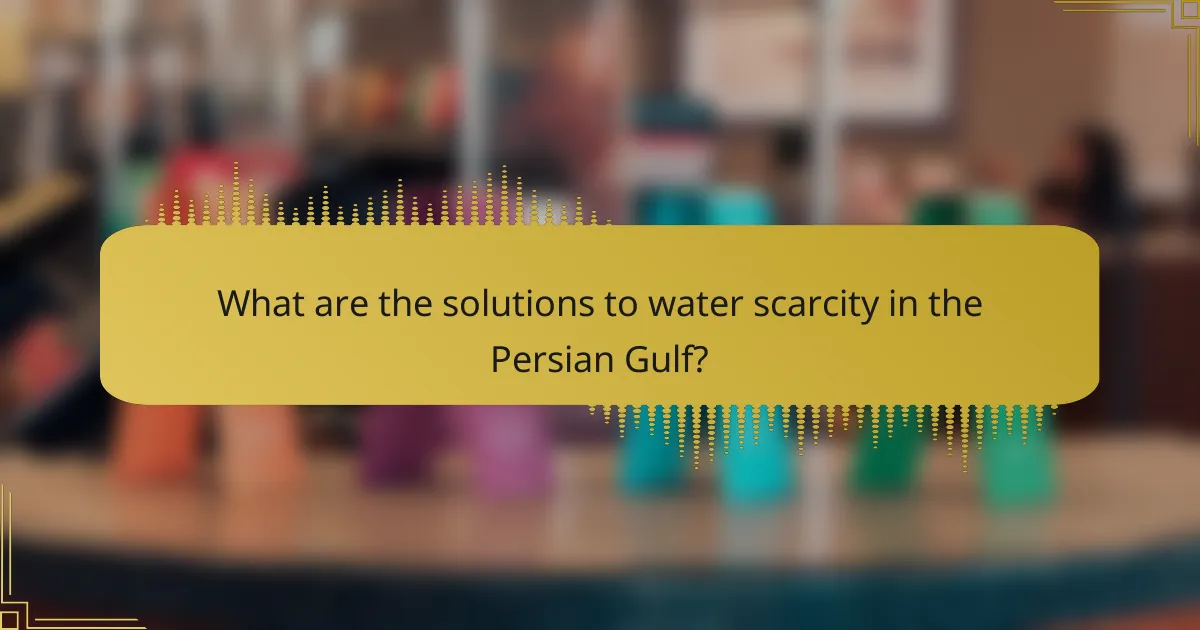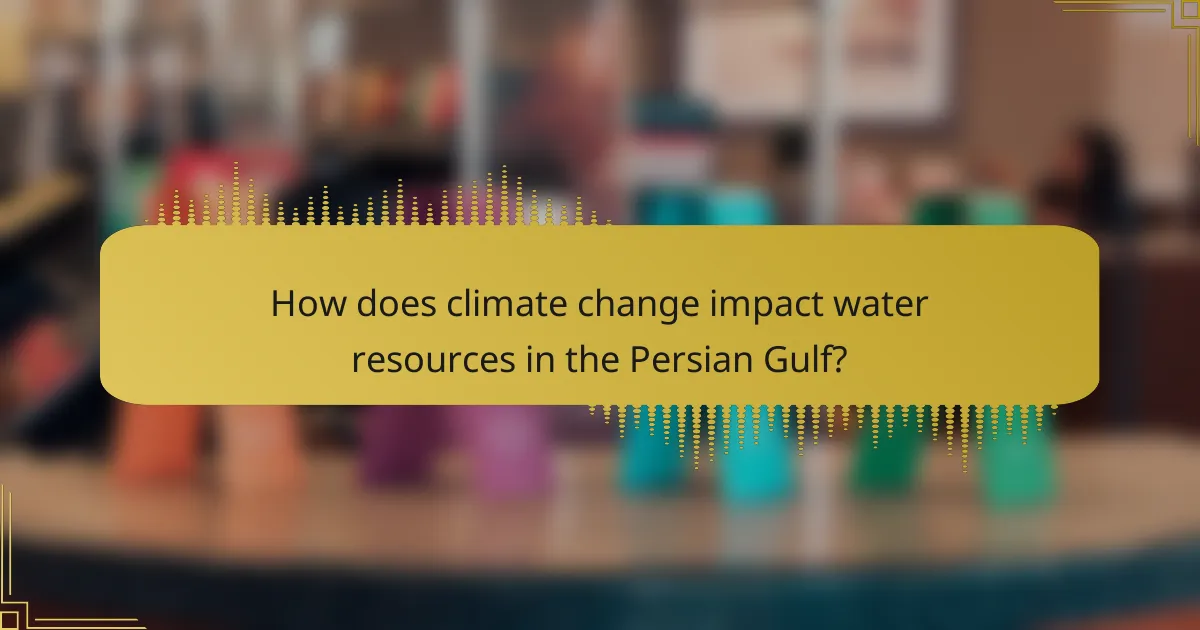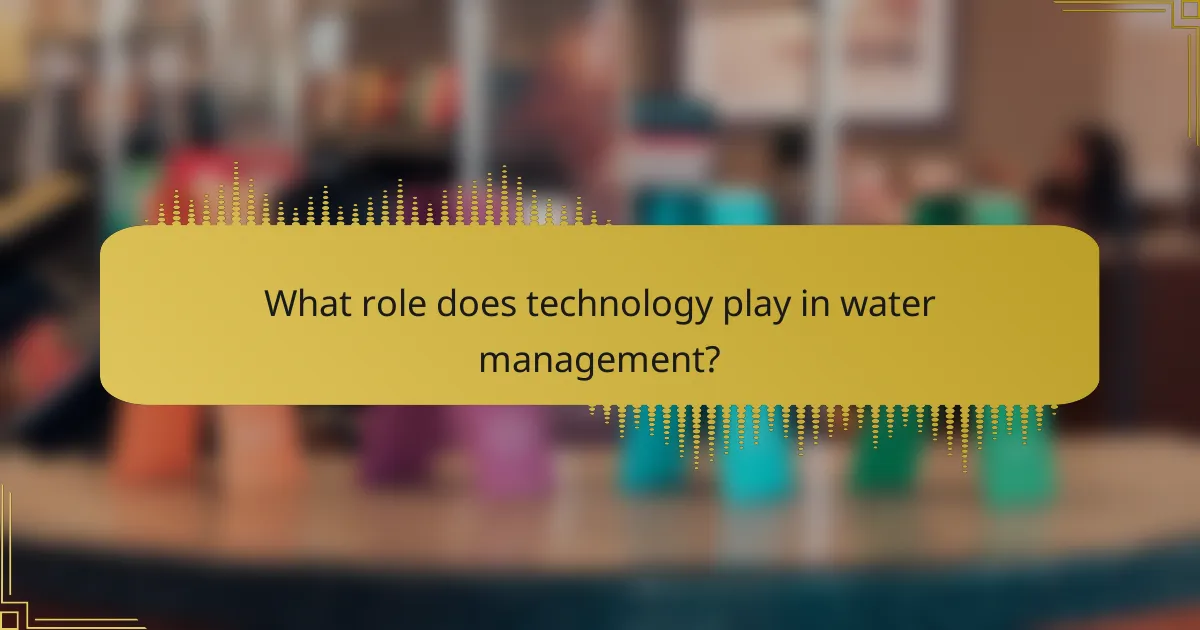The Persian Gulf faces significant water scarcity challenges exacerbated by climate change, which intensifies evaporation and disrupts rainfall patterns. To address these issues, innovative solutions such as advanced desalination technologies, water recycling initiatives, and regional cooperation are being implemented. Collaborative efforts among Gulf countries aim to enhance water availability and promote sustainable resource management, ensuring a more resilient future for the region.

What are the solutions to water scarcity in the Persian Gulf?
Solutions to water scarcity in the Persian Gulf include advancements in desalination technology, water recycling initiatives, regional water-sharing agreements, investment in sustainable agriculture, and public awareness campaigns. These strategies aim to enhance water availability and promote efficient usage in a region facing significant water challenges.
Desalination technology advancements
Desalination technology has seen significant advancements, making it a primary solution for water scarcity in the Persian Gulf. Modern desalination plants utilize reverse osmosis and thermal distillation methods, which are more energy-efficient and cost-effective than older technologies.
Countries like Saudi Arabia and the UAE have invested heavily in these technologies, producing millions of cubic meters of fresh water daily. However, the environmental impact, such as brine disposal, must be managed carefully to avoid harming marine ecosystems.
Water recycling initiatives
Water recycling initiatives are crucial for addressing water scarcity in the Persian Gulf. These programs treat wastewater for reuse in agriculture, landscaping, and industrial processes, significantly reducing the demand for freshwater resources.
For example, the UAE has implemented extensive greywater recycling systems that allow households to reuse water from sinks and showers. This approach not only conserves water but also promotes sustainable practices within communities.
Regional water-sharing agreements
Regional water-sharing agreements are essential for fostering cooperation among Persian Gulf nations facing water scarcity. These agreements facilitate the equitable distribution of shared water resources, such as rivers and aquifers, and encourage collaborative management strategies.
Countries can benefit from joint investments in infrastructure and technology, which can lead to more efficient water use and improved resilience against droughts. Successful examples include agreements on shared aquifer management between Oman and the UAE.
Investment in sustainable agriculture
Investment in sustainable agriculture is vital for reducing water consumption in the Persian Gulf. Techniques such as drip irrigation and drought-resistant crop varieties can significantly lower water usage while maintaining agricultural productivity.
Countries like Qatar are promoting hydroponics and vertical farming to maximize yield with minimal water. By prioritizing sustainable practices, the region can enhance food security while addressing water scarcity challenges.
Public awareness campaigns
Public awareness campaigns play a crucial role in combating water scarcity in the Persian Gulf. Educating communities about water conservation practices can lead to significant reductions in water waste.
Initiatives that promote simple actions, such as fixing leaks, using water-efficient appliances, and adopting mindful consumption habits, can create a culture of conservation. Engaging schools and local organizations in these campaigns can amplify their impact and foster long-term behavioral changes.

How does climate change impact water resources in the Persian Gulf?
Climate change significantly affects water resources in the Persian Gulf by increasing temperatures and altering weather patterns. These changes lead to heightened evaporation, shifts in rainfall distribution, and reduced groundwater replenishment, all of which exacerbate water scarcity in the region.
Increased evaporation rates
Rising temperatures due to climate change result in increased evaporation rates from water bodies, which diminishes available freshwater. In the Persian Gulf, evaporation can exceed 2,000 millimeters annually, leading to substantial losses in surface water resources. This phenomenon is particularly concerning for countries relying on desalination, as higher evaporation rates can strain water supplies.
Altered precipitation patterns
Climate change disrupts traditional precipitation patterns, causing irregular rainfall in the Persian Gulf region. Some areas may experience prolonged dry spells, while others could face intense, short-lived storms that lead to flooding but little groundwater recharge. This unpredictability complicates water management strategies and increases reliance on alternative sources, such as desalination.
Impact on groundwater recharge
Groundwater recharge is adversely affected by climate change, as reduced precipitation and increased evaporation limit the natural replenishment of aquifers. In the Persian Gulf, over-extraction of groundwater for agriculture and urban use further exacerbates this issue, leading to declining water tables. Sustainable management practices are essential to protect these vital resources and ensure long-term water availability.

What regional cooperation exists to address water scarcity?
Regional cooperation in the Persian Gulf focuses on collaborative efforts to mitigate water scarcity through shared initiatives and strategies. Countries in the region are increasingly recognizing the need for joint action to manage water resources effectively and sustainably.
Gulf Cooperation Council (GCC) initiatives
The Gulf Cooperation Council (GCC) has launched several initiatives aimed at addressing water scarcity across member states. These initiatives include the establishment of a unified water policy and the promotion of water conservation techniques. Member countries often collaborate on infrastructure projects, such as desalination plants, to enhance water supply.
Additionally, the GCC encourages the sharing of best practices in water management and the adoption of advanced technologies to improve efficiency. Regular meetings and workshops facilitate knowledge exchange among member nations.
Joint research projects
Joint research projects among Gulf countries focus on innovative solutions to water scarcity challenges. These projects often involve universities, research institutions, and government agencies working together to study water resource management and sustainable practices. Collaborative studies may address topics like groundwater recharge, wastewater treatment, and climate change impacts on water availability.
Such research efforts aim to develop actionable strategies that can be implemented regionally, ensuring that findings are relevant and beneficial to all participating nations.
Cross-border water management strategies
Cross-border water management strategies are crucial for effectively addressing water scarcity in the Persian Gulf. Countries often share water resources that cross national boundaries, necessitating cooperative agreements to manage these resources sustainably. Examples include joint monitoring of shared aquifers and coordinated drought response plans.
Implementing these strategies requires clear communication and agreements on water allocation, usage rights, and conservation efforts. Establishing a framework for cooperation can help mitigate conflicts and promote equitable access to water resources across the region.

What are the key challenges in managing water resources?
Managing water resources in the Persian Gulf region faces significant challenges due to a combination of environmental, social, and economic factors. These challenges include rapid population growth, over-extraction of groundwater, and pollution of water sources, all of which strain the already limited water supply.
Population growth and urbanization
Population growth and urbanization in the Persian Gulf countries have led to increased demand for water resources. Urban areas are expanding rapidly, resulting in higher water consumption for domestic, industrial, and agricultural uses. This surge in demand often outpaces the development of sustainable water management practices.
As cities grow, infrastructure struggles to keep up, leading to inefficiencies in water distribution and increased wastage. It is crucial for policymakers to implement effective urban planning and water conservation strategies to address these challenges.
Over-extraction of groundwater
Over-extraction of groundwater is a critical issue in the Persian Gulf region, where reliance on aquifers is high due to limited surface water. Excessive pumping has led to declining water tables and the degradation of water quality, making it unsustainable in the long term.
To mitigate this issue, countries need to adopt regulated extraction limits and invest in alternative water sources, such as desalination and wastewater recycling. Public awareness campaigns can also encourage responsible water use among residents and industries.
Pollution of water sources
Pollution of water sources poses a significant threat to the availability of clean water in the Persian Gulf. Industrial discharges, agricultural runoff, and urban waste contribute to the contamination of both surface and groundwater supplies.
Implementing stricter regulations on waste management and promoting environmentally friendly practices in agriculture and industry are essential steps. Regular monitoring of water quality can help identify pollution sources and facilitate timely interventions to protect water resources.

What role does technology play in water management?
Technology plays a crucial role in enhancing water management by optimizing usage, improving efficiency, and ensuring sustainability. In the context of the Persian Gulf, advanced technologies can help address water scarcity challenges through innovative solutions tailored to the region’s unique needs.
Smart irrigation systems
Smart irrigation systems utilize sensors and automated controls to optimize water usage in agriculture. These systems can adjust watering schedules based on real-time weather data and soil moisture levels, significantly reducing water waste. For instance, farmers in the Gulf region can save up to 30-50% of water by implementing these technologies.
When selecting a smart irrigation system, consider factors such as the type of crops, local climate conditions, and soil characteristics. Additionally, integrating these systems with mobile applications can provide farmers with valuable insights and alerts, enhancing decision-making.
Water quality monitoring tools
Water quality monitoring tools are essential for ensuring that water resources remain safe and usable. These tools can detect contaminants and measure parameters such as pH, salinity, and turbidity, which are critical for maintaining water quality in the Persian Gulf. Regular monitoring helps identify pollution sources and assess the effectiveness of water treatment processes.
Implementing water quality monitoring systems can involve using handheld devices for field testing or installing continuous monitoring stations in key locations. It is important to follow local regulations regarding water quality standards to ensure compliance and protect public health.
